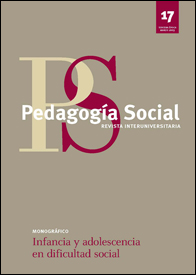Representaciones sociales que influyen en las políticas sociales de infancia y adolescencia en Europa.
DOI:
https://doi.org/10.7179/PSRI_2010.17.02Palabras clave:
Infancia, adolescencia, juventud, jóvenes, representaciones sociales, categorías sociales, diferenciación categorial, estereotipos, creencias, tweens, Childhood, adolescence, youth, young people, social representations, social categoriesResumen
Se revisan y analizan algunas creencias, estereotipos y representaciones sociales prevalentes en la sociedad occidental sobre la infancia, la adolescencia y la juventud, tanto en el presente, como en perspectiva histórica. Se ofrecen ejemplos de cómo han cambiado o están cambiando algunas de estas creencias o representaciones compartidas, y se señalan algunas de las consecuencias sociales y políticas que derivan de las mismas. Se subrayan tanto el reciente “descubrimiento” de la infancia como capital humano y social, como su potencial para generar nuevos datos, porque configuran una nueva oportunidad de hacer visibles diferentes aspectos de la sociedad que implican a los ciudadanos más jóvenes, y que han sido tradicionalmente invisibles. Un cambio de actitudes es necesario entre los adultos, incluidos los investigadores, para que sean posibles nuevas formas de relaciones intergeneracionales, y con ese propósito se analizan algunos retos cuyo abordaje posibilitaría nuevas dinámicas sociales.
-----------------------------------------------------------------
Prevalent believes, stereotypes and social representations of childhood, adolescence and youth in the western society are overviewed and analysed at present, and also in historical perspective. Examples of how some of this shared believes and representations have changed or are changing recently are offered, and some of the subsequent social and political consequences are pointed out. The recent “discovery” of childhood as human and social capital and its potential to generate new data are underlined as a new opportunity to make socially visible different aspects of society involving citizen young people that have traditionally been invisible. A change of attitudes is needed among adults – including scientific researchers - to make possible new forms of intergenerational relationships and some challenges are analysed in order to make possible new social dynamics in that direction.
Descargas
Descargas
Publicado
Cómo citar
Número
Sección
Licencia
Derechos de autor 2014 Pedagogía social. Revista interuniversitaria

Esta obra está bajo una licencia Creative Commons Reconocimiento-NoComercial 3.0 Unported.
Derechos de reproducción y archivo
La versión publicada de los artículos podrá ser autoarchivada por sus autores en repositorios institucionales y temáticos de acceso abierto. No obstante la reutilización total o parcial de los mismos en nuevos trabajos o publicaciones deberá ser autorizada por Pedagogía Social. Revista Interuniversitaria.
Los trabajos publicados deberán ser citados incluyendo el título de la Revista, Pedagogía Social. Revista Interuniversitaria, nº, páginas y año de publicación.
Responsabilidades éticas
Pedagogía Social. Revista Interuniversitaria no acepta material publicado anteriormente en otros documentos. Los/as autores/as son responsables de obtener los permisos oportunos para reproducir parcialmente material de otras publicaciones y citar correctamente su procedencia. Estos permisos deben solicitarse tanto al autor/a como a la editorial que ha publicado dicho material.
Es obligación de Pedagogía Social. Revista Interuniversitaria detectar y denunciar prácticas fraudulentas.
En la lista de autores/as firmantes deben figurar únicamente aquellas personas que han contribuido intelectualmente al desarrollo del trabajo.
La revista espera que los/as autores/as declaren cualquier asociación comercial que pueda suponer un conflicto de intereses en conexión con el artículo remitido.
Los autores deben mencionar en el manuscrito, preferentemente en el apartado del método, que los procedimientos utilizados en los muestreos y controles han sido realizados tras la obtención de consentimiento informado.
La revista no utilizará ninguno de los trabajos recibidos con otro fin que no sea el de los objetivos descritos en estas normas.
Aviso de derechos de autor/a
© Pedagogía Social. Revista Interuniversitaria. Los originales publicados en las ediciones impresa y electrónica de esta Revista son propiedad del Pedagogía Social. Revista Interuniversitaria, siendo necesario citar la procedencia en cualquier reproducción parcial o total.
Salvo indicación contraria, todos los contenidos de la edición electrónica se distribuyen bajo una licencia de uso y distribución “Creative Commons Reconocimiento-No Comercial 3.0 España” (CC-by-nc). Puede consultar desde aquí la versión informativa y el texto legal de la licencia. Esta circunstancia ha de hacerse constar expresamente de esta forma cuando sea necesario.






